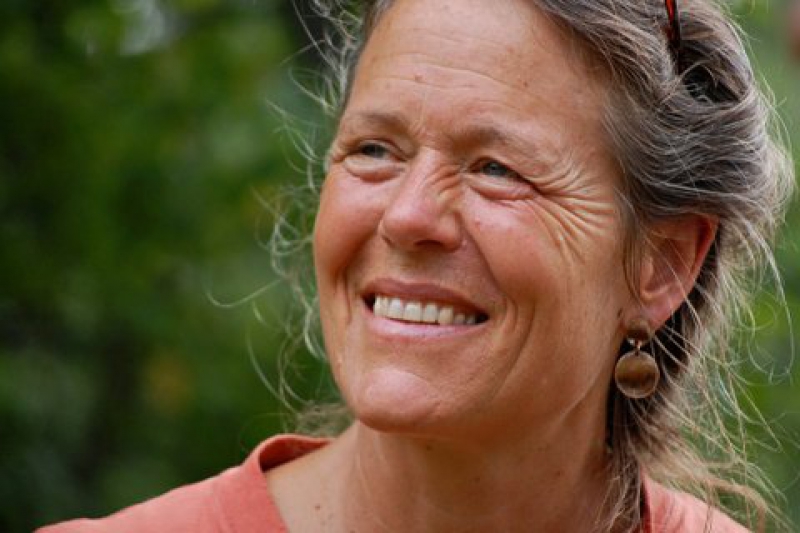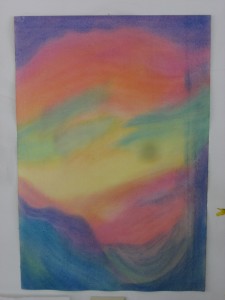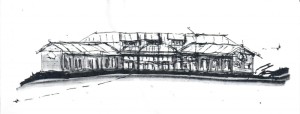Inner Fire offers a different approach to mental illness and addictions: art
By Katherine P. Cox
They reach rural Vermont seeking peace from the tumult of their lives and healing from the illnesses and addictions that feed that turmoil. At Inner Fire in Brookline, adults suffering from mental illnesses and addictions spend a year in an intense farm-based, artistic program that helps bring order back to their lives through various therapies, diet, work, and outdoor experiences in a bucolic farmhouse setting amid meadows and fields.
It’s all done while tapering off or even foregoing the psychotropic medications traditionally prescribed as the first course of treatment for those suffering from mental illnesses.
And because words matter, Beatrice Birch and her husband, Tom Kavet, who founded Inner Fire, say “mental illness” is a reductionist view. They refer to such challenges as “soul illness.”
“Inner Fire is all about choice,” Beatrice Birch says. “It’s a community for people recovering from debilitating traumatic experiences without the use of psychotropic drugs.”
The key, she explains, is rhythm and order: “You can’t create inner order if your outer life is chaotic. Everyone has a schedule. Everything is therapeutic. When you garden, for example, you tend something and nurture it and create beauty. Food feeds the body but beauty feeds the soul.” It is the soul that is out of balance when a person is dealing with mental illness, abuse, trauma, and addiction, she says.
Inner Fire’s six patients, or seekers, as they’re called here, are working their way through a yearlong day program that began in September. Their day begins at 7 a.m. and ends at 8:30 p.m. Depending on the season, they work in the gardens and forests on the property. They cook, using all local and organic food, and tend to housekeeping chores — “learning how to take care of their shelter,” Birch says.
After a rest, during which time the seekers receive liver compresses, they participate in group counseling and one-on-one sessions that include art therapy.
The arts, central to the healing process for the seekers at Inner Fire, include music, spacial dynamics, eurythmy, speech arts, and biographical work. Birch, who has been working in Europe and the United States with Hauschka Artistic Therapy for more than 30 years, explains the art therapy is a non-analytic, proactive process that works with the relationships between the individual’s body and soul. She says her experience enables her to recognize the needs of the individual in relation to the medium that would be most supportive in their journey of healing.
Typical media used here are watercolors, clay, pastel, and charcoal. They help rebuild a life.
“I meet people here as creators, not victims. But you have to honor that they can feel a victim because of various traumas. When you can claim that trauma is an opportunity for growth, then one can feel ‘I am a creator,’” Birch explains.
After conversation and consultation, Birch determines which medium is most appropriate. She says that for someone who has “lost their center, I would lean toward clay or pastel. Fingers and thumbs are tools to mold: it brings consciousness to your fingertips and is very grounding. Clay offers some resistance. You can begin to strengthen your will.”
Birch guides the process, there for the seeker as work takes shape. In clay modeling, she says, the first step is to “cause chaos by mushing and gushing” and then to compress the clay into a harmonious sphere. As clay is added and the process is repeated, “letting go” is practiced until the appropriate size of sphere is reached. “Then they can do a free form with a theme,” Birch says.
Another way to work the clay is to take three moods — anger, shock and peace — and try to capture those emotions in the facial expression of the head of clay they’re creating.
“They’re exploring that emotion; they can talk about what they’ve created. It’s a way of looking objectively at emotions that people are dealing with,” Birch says.
Moreover, seekers must claim it to express it, she adds. “It’s all about exploring; it’s not judgmental.” Indeed, the clay work “pulls them down into their fingertips, awakening tactile senses. [It] helps them focus and get grounded. It doesn’t happen overnight.”
For many people dealing with mental/soul illnesses and addictions, treatment may include medications that can cause humiliating and debilitating side effects. Wary of these, some patients avoid the drugs, and face added difficulty in dealing with their problems. Working with clay, though, helps them to “center” and work through the emotions and temper their reactions that get them into trouble and allows them to reengage with new energy — and without drugs, Birch says.
On the other hand, for someone stuck in their pain and turned inward, Birch says she would turn to watercolor painting.
“Water is a living element and needs your attention and wakes you up. Because of the beautiful luminosity of color it warms the soul, and people can begin to breathe out and let go.”
At Inner Fire, music, too, is evoked to nourish the soul. Speech arts (using prose and poetry) help those “to claim the voice they have lost,” Birch says. Drumming awakens the individual within the community. Eurythmy, a form of expressive movement, works with the forces of contraction and expansion, and spacial dynamics supports the experience of the dignity of the human being in space.
All these therapies support proactive individuals on different levels, Birch says. “Healing is the process of tapping untapped wells within our innermost soul.”
To tap those wells, therapy at Inner Fire addresses what Birch describes as the “four parts” of a human being: the physical body; the etheric body (“the home of our memories and habits which influences our sense of well-being”); the astral body (“the home of our sympathies and antipathies”); and the spirit, “which tries to orchestrate the other bodies harmoniously.”
When trauma throws the body out of balance, Birch says, “the spirit is unable to engage as fully as is needed for health. The various therapies offered at Inner Fire work upon the four-fold human being in specific ways and thus helps to initiate inner harmony.”
Nels Kloster, a Brattleboro-based psychiatrist and addiction specialist, says Birch’s philosophy resonates with him. Kloster, who many know as co-host of BCTV’s “Let’s Talk About Mental Health,” works with Pathways to Housing, a housing-first model for homelessness; Serenity House, which offers residential substance treatment; Habit OPCO, the methadone clinic; and in private practice, where he treats addiction at Bennington’s Hawthorn Recovery Center.
“I’ve long been concerned for what I’ve seen as psychiatry’s over-reliance on medications. Research suggests that our broad use and heavy use of medications can be detrimental. Many of us note this approach has a disempowering impact for individuals.”
He says he was introduced to Birch’s work in readings and discussions on the issue with colleagues and authors, and found himself “eager to become involved with Inner Fire’s development of a healing community where seekers develop foundations to wellness and have choices other than medications.”
Although Birch offers no specific data regarding artistic therapy versus medication, she said her many years’ experience has shown her that “what is real is actually experiencing the changes in the individuals, and how they can pick up and claim their lives again.”
One seeker, whose name we are withholding for privacy reasons, who had been at Inner Fire just a month, describes the healing she was already experiencing. This person had spent 25 years on a number of psychiatric drugs.
“Due to my acute withdrawal symptoms, I knew I needed a place where my brain could be quiet and my nervous system wouldn’t be overwhelmed, and where I would not need to worry about being drugged, hospitalized, or arrested if I screamed or became out of control due to withdrawal. It is extremely challenging at times, however, I feel safe. I can relax and trust that with time and the loving arms of the Inner Fire community, I will continue to become stronger so that I can resume my life in a much more holistic, happier way,” she says.
For more information, visit http://www.innerfire.us. An interview with Beatrice Birch appears on BCTV’s “Lets Talk about Mental Health” at http://www.youtube.com/watch?v=sDu3zlF7fvA.

























































